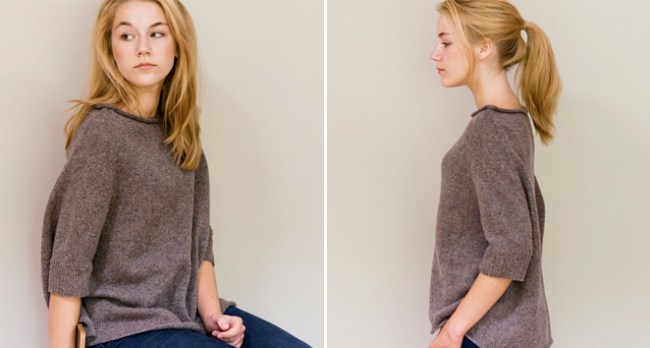Once in awhile, I make a point of eating a food I think I don’t like, talking politics with a person whose views are the polar opposite of mine, letting someone point a camera at me. I try not to get locked into my opinions, habits or worldview, in other words. People are changeable creatures, and it turns out vegetables are delicious! Anyway, I was stopped short recently by something Julie Hoover (designer of these recent Favorites) said on her blog, and so I asked her about it.
Thanks so much, Julie, for the thoughtful response —
.
Q: You recently posted on your blog with regard to your Hayward pattern: “The seams up the sides and deep raglan shoulder shaping help the garment to hold together structurally (just in case you’re inclined to knit it in the round — think twice!) and give you the opportunity to expose the seams during finishing for a more urban look.” I’m a top-down devotee, definitely inclined to knit this one in the round, from the top, but am curious what finesse or detail I might be missing. Stabilizing side “seams” and deep raglans are possible with top-down, so I’m wondering whether you could elaborate on your parenthetical above. Do you just find sewn seams to be more stable (or attractive), or is there more to it than that?
Julie Hoover: It’s a personal preference, for sure. It’s also the way I was trained to construct certain garments — in pieces. Deciding what technique to use is subjective from designer to designer and from knitter to knitter, and there’s always a case to be made for making an exception to the rule.
I like to knit garments from the bottom up because I prefer the look of a decrease stitch over an increase stitch, visually. You might find the opposite to be true for you. There are other reasons as well, but that’s the main one.
Generally, I don’t object to a garment knitted in the round if the entire garment is knitted that way. A knitter’s gauge can vary quite a bit when knitting back and forth vs. knitting circularly, so there’s always that to consider.
As for seamless vs. seams for Hayward … I’d have to hear exactly what “reinforcement” technique you would use to replace a seam and give it a try in order to know whether I would find it as suitable as the real thing. That might sound a bit inflexible, but particularly when working an oversized garment that has stress points at the shoulders and neckline seam areas (as Hayward does), you have to think of the seams as you would the load beams that support your home. Over time, you want them to be as strong as possible. I understand that many people hate seaming, and no matter what, they will avoid it. I certainly am not going to argue with them! But for me, I love the change in pace it offers at the end of a project, to slow down and see it all come together. Most importantly, I know that after all the time it took to knit, my garment is going to have the professional finishing touch it needs to last over time.
.
And just like that: worldview challenged. I’m still seriously pondering doing a top-down version of Hayward (I bought the pattern) — and may have daydreamed briefly about the specs and benchmarks for an A/B test of seamed and unseamed versions — but I often think I should at least consider knitting a seamed garment, and this exchange has given me new reasons to think so. I might even learn to love it.
How about you — thoughts on all this?

